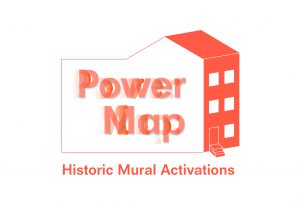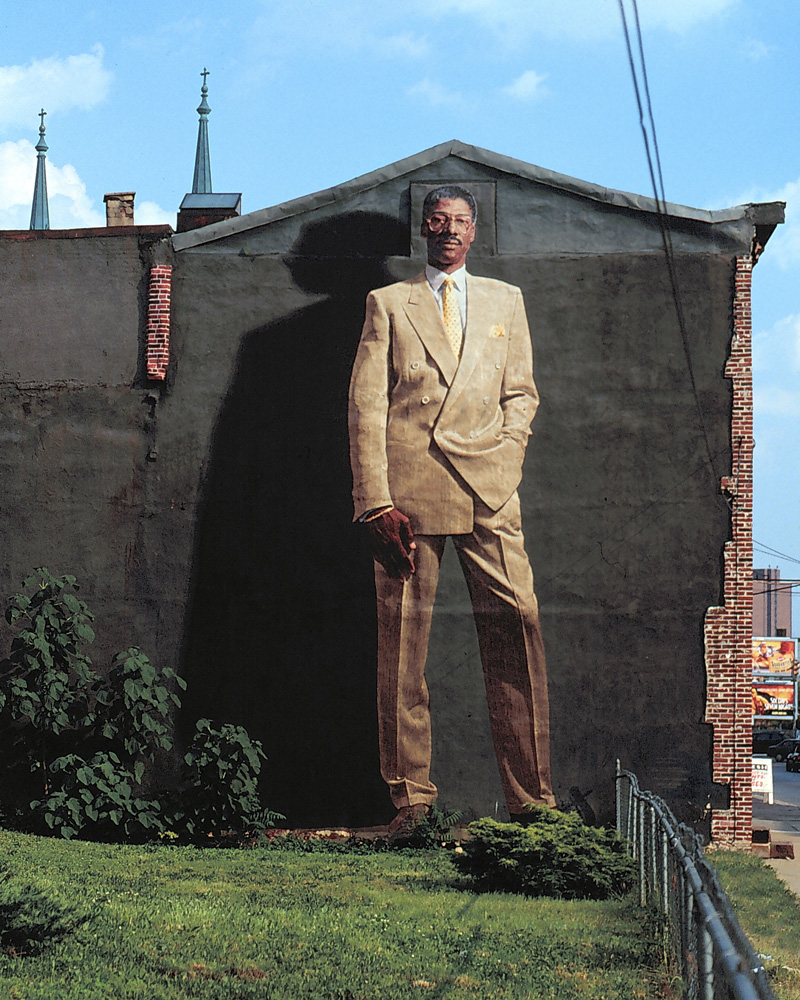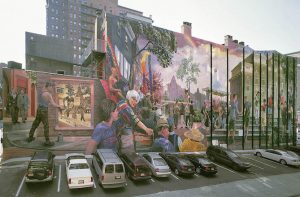Power Map: Looking Back, Looking Forward
By Daniel Tucker (October, 2020)
What do murals see? They inhabit the walls of a neighborhood, at times outliving generations growing old and others simply passing through. Though they arise through a process and at a moment, are made by multiple hands – all of that is not apparent in the end result.
In the case of the five early murals that were selected as sites for Power Map: Historic Mural Activations, they came about in a distinct moment in the life of Philadelphia and in the life of the organization that produced them, first known as Anti-Graffiti Network and now called Mural Arts Philadelphia (MAP). They span from 1984 – 2003 and in every instance of their creation there are aspects of the process that MAP has now more-or-less codified into community engagement strategies, aesthetic and representational techniques, and even technical tactics for executing wall painting or staging a public event. Now the organization is 35 years old, and this project is part of the work of looking back to see what the murals have witnessed in their lifespan.
These five murals have diverse geographic and architectural settings, and the stories that led to their creation, told only partially in the words below, will reveal the many ways that their imagery was determined. But one thing that ties them together is the figure – using depiction of the body to create identification with the viewer and show different kinds of power and empowerment. As each mural shows through a raised arm, a suit, images of family roots, the positive depiction of community joyfully celebrating, and the depiction of emboldened direct action – each offers us a lesson about what it means to possess or claim power and how to represent that in art.
The title of this project is inspired by the practice of “power mapping” which is a form found commonly in community organizing. One of the conventions of a power map is to create a visualization of who might be in agreement or disagreement around a particular issue. This emphasis on Agree/Disagree, or Yes/No, can be seen as the foundation of politics, but it can also connect to the representation of either affirmative or negative depictions of a community that are so essential to the history of muralism.
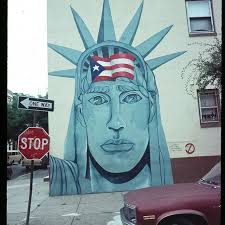
Puerto Rican Statue of Liberty by Dietrich Adonis, Carlos Vasquez, Glenn Hill, Jane Golden (1984). Photo courtesy Jim Prigoff.
A stark contrast from the less contestatory murals that dot the city today as well as the pastoral and multicultural murals of the same period, the “Puerto Rican Statue of Liberty” stands out for its depiction of the unfurled Puerto Rican flag covering the brow of the Statue of Liberty. My research has revealed that the mural was originally painted (presumably sometime in the early 1980s) by an anonymous graffiti artist honoring the 1977 independence activist takeover of the Statue of Liberty, making it a kind of documentary mural. When it was covered up by HUD workers in 1984, the largely Puerto Rican neighborhood called then-Mayor Wilson Goode to repaint the original image. Goode deployed the newly created Anti-Graffiti Network to repaint the mural, though they had to consult photographs and used wall paint instead of spraypaint due to their position in a graffiti-diversion program. This led to the mural entering routine maintenance and restoration as part of the organization’s permanent collection.
Thirty years later “Puerto Rican Statue of Liberty” still stands in the Fairmount neighborhood despite the fact that the Puerto Rican community has largely shifted to another neighborhood. The mural has since become a site of convergence for the former residents, both displaced and those who moved voluntarily, at annual homecoming picnics. Every time a developer threatens to paint over the mural the word spreads, a protest takes place, and calls come flooding into MAP. Jane Golden, MAP’s Executive Director, said in an interview that there is a predominantly white group of homeowners that have made their own noise about the mural: “They have managed to bully their way into this position that there will be no new murals in this neighborhood because they just hate murals… I love the fact that it is there. In their hearts, they don’t want to be seen as politically racist. They are much more subtle. I love the fact that after we fixed it up there was a ceremony.”
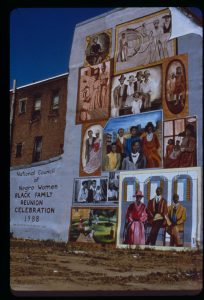
Black Family Reunion by Dietrich Adonis and Jane Golden (1988). Ernel Martinez (Restored 2001/2008). Photo courtesy Jim Prigoff.
The next mural in this series was Black Family Reunion, from 1988 next to West Fairmount Park. As Golden said in our interview, “When we started doing murals, it is not like there was a waiting list or a formal wait period for requested murals. Once we did a few murals and they were popular, people would just call the office or connect with our boss and ask for murals, or they’d see us in the neighborhood and they’d ask for murals. So, in ’88, our office was located in City Hall annex which is now the Marriott Courtyard and down the hall was a woman Barbara Daniel-Cox and she was in charge for the city of the Women’s Commission. As part of her portfolio, another thing was overseeing these Black Family Reunion festivals that would happen every year and it was a major picnic in the park. People would come all over, primarily from the south, and there would be two weeks of programming and all kinds of interesting sessions, guest speakers and activists. So, I guess it happened in ’87, and when it happened in ’88, Tim Spencer called a meeting and said that Barbara and I would like you guys to do a mural as tribute to the Black Family Reunion. I remember the Black Family Reunion was opening in July and this was June so I was like, ‘oh my goodness we really have to rush.’”
Because the process had a fast turn around, the team went to the historical society and the Charles L. Blockson Afro-American Collection at Temple to find photos that related to Black migration to Philadelphia. The images became the motif for the mural, with various ornate frames containing heirloom portraits and scenes from rural life in the south. It occurred to me that the resulting mural represented only the positive part of the great migration, and did not deal with the ways that it was forced through white supremacist violence. In response to this concern, Golden explained that “We didn’t have a body of work so we would show murals. We had books of murals from L.A., Chicago, and San Francisco, particularly Chicago, we would show people the depiction of work that was way more political. To a person…[the answer was] just no…Our community has been so neglected that we just can’t bear a negative image. We heard that a million times. I think if one were to critique the work more harshly they could say it was sentimental.”
The argument around “positive images” was very developed by that time, with regard to arts generally and murals specifically. In a 1967 review in Ebony magazine of Chicago’s famous “Wall of Respect” mural, often lauded as the birthplace of the outdoor community murals movement in the United States, the author writes that the artists chose “images of dignity” and Jeff Donaldson, one of the artists reflected years later that “the theme ‘Black Heroes’ was chosen to include men and women, role models for positive self-identification and guidance towards Black liberation.” (Donaldson, 1991) Donaldson was part of AfriCOBRA alongside Barbara Jones Hogu who wrote of their approach to artmaking in 1973 that “We were aware of the negative experiences in our present and past, but we wanted to accentuate the positive mode of thought and action. Therefore our visual statements were to be Black, positive and direct with identification, purpose and direction.” (Hogu, 1973)
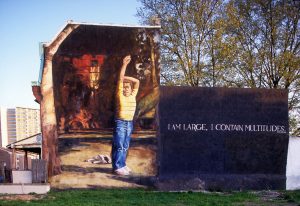
Boy with the Raised Arm by Sidney Goodman (1990) and repainted by Brian Senft (2002). Photo courtesy Jack Ramsdale.
This premise informs the next two murals in the series: “Boy with a Raised Arm” by Sidney Goodman (1990) and “Dr. J” by Kent Twitchell (1990). While the previous example was produced internally by the organization, “Boy with a Raised Arm” in the West Powelton neighborhood, 1 came about through an interest in inviting more conventional fine arts painters like Charles Searles, Richard Watson, James Dupree, Sidney Goodman, Bo Bartlett, and Vincent Desiderio to collaborate with the youth who were part of the Anti Graffiti Network. The original premise was to take the core group of 10-20 youth who were becoming more advanced artists and do an exhibition of large-scale canvas collaborations with these artists at Nexus gallery. The youth were really drawn to Goodman’s work and so it was decided with the youth’s input to take an existing painting of a boy proudly (or perhaps playfully) gesturing with his arms and adapt it to a wall mural.
While many mural viewers assume “Boy with the Raised Arm” might be an image derived from Black Power salutes or of a young person from the neighborhood, it was in fact based on some photographs that Goodman took with permission of a boy in Rittenhouse Square. Golden recounts that the teenagers involved in the project liked that the figure was not a famous person, but that it could be read as being about empowerment. The addition of he Walt Whitman-derived text “I am Large, I Contain Multitudes” used in the mural was inspired by the original architecture on which the mural was to be painted: the selected wall had a vertical portion well-suited for the painting of the boy and a horizontal that could allow for the additional caption that was not present in Goode’s original work..
Golden recalls neighbors doing door-knocking to get permission to paint the mural and the building owner being involved in the process. She describes the scene as the mural was being painted as being highly dynamic, with people dropping by with food, and kids dancing and making music. Mr. June was a neighbor who ran local enterprises and youth programs out of a school bus in an empty lot next to the mural. Golden reflected that “Later, we’d talk about it as a community methodology or mural process and I think perhaps the best training of all was for us to go and not be prescriptive and let things bubble up and take it from there.” Years later, when the empty lot was threatened with development, MAP worked with the Red Cross who was building on the site to recreate the mural on the corner of their building and the quote was then placed underneath. Since 2015, Goode’s original painting now resides in the Philadelphia Museum of Art’s permanent collection and a lithograph based on the painting can be found in the permanent collection of Pennsylvania Academy of Fine Arts.
The final two murals were determined in extended discussions with the Community Murals department at MAP, who proved to be invaluable resources to generate ideas about the sites they deemed to be most beloved and which helped to tell the history of the organization.
“Dr. J” was a mural created the same year as “Boy With the Raised Arm” with quite the opposite of the non-celebrity anonymity that offered appeal in the figure of the previous example. This larger-than-life mural depicted Julius Erving, the longtime Philadelphia 76ers basketball star who had at that time recently retired.
Representing a shift in the organization’s development, “Dr. J” was the first time MAP received a grant to support their work. By that point, one of the graffiti writers that had been involved as a teenager with Anti Graffiti Network, Theodore Harris (still active in Philadelphia arts today), took initiative in shaping many projects. Harris had a cousin working at Pennsylvania Council of the Arts to whom they went with a proposal for inviting an out-of-town artist – another first for the organization. Golden approached Kent Twitchell with whom she had worked in her time in Los Angeles (both were featured in the 1980 documentary about LA murals, Mur Murs, directed by Agnès Varda). She recounts that “We applied for 5,000 dollars. I think that 2,500 to bring him to Philadelphia to do a mural. I remember when I had to call Kent to ask him to do a mural I said, ‘We had this really modest sum of money’ and I knew he gets a lot of money from a mural. He said, ‘I’ll come if I can do Dr. J in a suit.’ And I was like, ‘That’s Fascinating. Why?’ ‘Because I want kids to think beyond sports.’ And I was just like, ‘Okay!’ And we proceeded to track down Dr. J, got his permission, and then Kent came in and Dr. J posed, and he took all the photos.”
In our interview Twitchell talked about what motivated him to do this work (his first outside of Los Angeles) “Dr. J was an entrepreneur and great philanthropist and he brought a unique art to playing…my murals have always been about painting monuments to American cultural heroes, not as celebrities but as people who have had a positive impact on people’s lives…being inspired in this fallen world is important. It is cool to be cynical rather than being positive.” Elaborating on positive images and scale, he continued “I was stationed in England in the Air Force and I think I probably got into that when looking at churches. When you would look at the spires and see the clouds go behind them, it would do something to you, it was unmistakable. It would make you feel good and in awe. And the greatest creation of God is people. I wanted to paint people singular and cathedral-like in a world that is so often discouraging.”
Twitchell had previously been a sign painter and brought these techniques to Mural Arts which changed their practice dramatically. This project was a breakthrough for Twitchell, working on this scale with parachute cloth to tile the work. Golden said “Kent was here for months and took us through the process of blowing up the photos, so they became granular and how he made it into slides and projected it onto sheets of parachute cloth and made these dots. He showed us how he mixed his colors from this value scale of 1 to 15. For the kids, it was just amazing. They loved working on this project.” Today MAP and organizations all over the world rely on his innovative technique of painting on parachute cloth, variously calling it Mural Cloth, Parachute Cloth, and Polytab. The chemical component of this material makes it like painting directly on the wall.
By the time “Pride & Progress” was painted in 2002 by Ann Northrup, the techniques being formed in the first four murals were much more solidly established. What makes this mural noteworthy in the course of MAPs development is the way that partnership functioned. Painted on the side of the wall of the William Way LGBT Community Center in a Center City neighborhood commonly referred to as the Gayborhood, this mural was initiated by the Washington Square Civic Association who held a contest to find an artist for this prominent wall. The project was originally awarded to a non-figurative artist but William Way wanted a figurative mural since the context was so tied to social movements and so eventually this led to Ann Northrup being considered.
Northrup recalled in our interview that the review panel asked her many challenging questions about her insights into the lived experience of LGBTQ people as a cis-gendered straight woman, and why she wanted to do this work. Sharing with them her personal and familial connections to queer communities and individuals, she also suggested that her greatest excitement for the project came from being out of the studio making work that is in dialogue with communities. She recalled that this took some growth on her part, remembering an instance when a passerby asked her to explain the reason there were “men dancing with men and the women dancing with women” and that she shyly offered the non-answer of “that’s just the way it is.” Frustrated by this experience she challenged herself to be more of a direct spokesperson in the future. Northrup recalls that “I worked with the board [of William Way] on the content, to present the happy life that would be possible if it was not for all the injustice.” This approach emphasizing assimilation and positive normality were indicative of the times, though do not reflect all of the battles taking place then or continuing today about the politics of inclusion, authorship or representation. She said throughout the process people would approach her on the scaffolding saying “you left out the leatherman, you left out the Bears, and on the day of the public mural dedication someone said ‘you left out the bitter old queen.’” And so when there was a chance to add a side piece in the mural she decided to focus on the politics, with the history of Annual Reminders protests.
These historic murals have seen a great deal of change. They’ve seen the city change, the lives of the participants and artists, the strategy of the organization that sponsored them and the partners who collaborated on them, and they’ve seen ideas about representation that informed them both become engrained and also questioned. Looking out, they can offer us lessons from the past and instructions for the present.
Looking Forward
In the Fall of 2018 I began meeting with Mural Arts Philadelphia in order to plot a project that would eventually become “Power Map”. As part of that process I met with numerous staff and artists to better understand everything about their work, and came to focus my attention on a few questions: how has the way artists have depicted power and empowerment in projects changed over time? And how can the organization’s long history of murals inform their work looking forward even though it increasingly takes forms other than murals?
To be sure, these are not questions that motivate all curators, but as a curator-in-residence with a longstanding relationship with the organization – I was committed to creating a project that could serve the ongoing work and growth of everyone already involved at MAP, while also bringing some new perspectives on past work. Drawing from my work with Rebecca Zorach doing “unfurlings” of local artists archives (see Never-the-same.org), the idea emerged to do “historic mural activations” as a way to get non-mural artists working in Philadelphia today to put the early murals from the “collection” into dialogue with contemporary issues and concerns. That a public art organization even has a collection was not always front-and-center, as there are often more energy and resources put into new work rather than revisiting historic work. And so the inquiry in the project tried to create something “in between” to see how the historic work does not stay fixed in time, and how there are always pressures of social life bubbling up around the walls.
While working on this project, discussions about the past and future of murals were taking place both nationally and locally, alongside campaigns to remove monuments. There was the call for removal of 1930’s murals such as Victor Arnautoff’s school mural in San Francisco (CAA, 2019) and the Ann Rice O’Hanlon mural at the University of Kentucky. The O’Hanlon mural’s dated and racist imagery received an intervention from Philadelphia artist Karyn Olivier in 2018, but when Breonna Taylor was tragically killed by police in nearby Louisville, students pushed for the mural to be removed. (Oliver, 2020)
Back in Philadelphia, MAP’s murals were also found in the heat of the moment. Vandals struck the mural of Cecil B. Moore in North Philadelphia with racist graffiti in February of 2020, the iconic MLK mural in West Powelton was under threat of development, and the ongoing saga over the mural of former Mayor and Police Chief Frank Rizzo came to a head.
MAP’s Rizzo mural, painted 25 years ago, became the site of immense conflict during the Summer of 2020 as Black Lives Matter demonstrations against police brutality against Black residents. Activists connected the present moment to the legacy of violence and racism in the Rizzo era. The mural was vandalized repeatedly and despite contention from those who saw the mural as an homage to their Italian-American heritage, it was eventually painted over (Ralph, 2020). The event launched both an interrogation of the processes used to create murals in the first place as well as lots of ideas of what it could be replaced with. While some argued playfully that it be replaced with the hockey mascot Gritty, it was Michelle Angela Ortiz, the mural artist and lifelong neighborhood of the 9th Street market corridor where the mural once stood, who created a project with public projections of video depicting a more inclusive and anti-racist imagery on the site to “cleanse” the wall (Ortiz, 2020).
Calls for removal can be seen in contrast to the examples of murals in Zapatista territory in Mexico that are freely edited and revised by the community or the live editing and ideological remixing of Chicago’s infamous Wall of Respect mural (Alkalimat, Crawford and Zorach, 2017). In the case of Zapatista mural alterations the art historian Luis Vargas Santiago writes that murals are both the spaces of “embodied practice” and “spaces for the construction of memory.” He continues that “In their ephemeral character, murals echo the foundational utopia of the Zapatista movement, which redefines itself as it goes, incorporating new experiences, revising history, and offering new challenges.” (Santiago, 2015) By enacting alterations in these spaces the community shows that there is fluidity and evolution to ideas.
The artists in “Power Map: Historic Mural Activations” took up the invitation to revisit specific murals and to consider what their site, aesthetic and the process used to create them could tell us about power and empowerment today. As part of the curatorial process I interviewed Jane Golden about the story of each mural along with the still-living muralists for murals Golden was not involved with painting (Sidney Goodman passed away in 2013). The audio was provided alongside newspaper clippings obtained by MAP project manager Kathy Poole to each artist when they accepted the invitation to participate in “Power Map” to offer them further context for the murals which would serve as prompts for them to make new artworks. As a curatorial process it was highly collaborative, with each artist/group engaging these archival materials as well as numerous site visits and meetings to talk through their plans and form connections with partners and residents connected to the mural sites.

We Exist in Multitudes by Tripod in collaboration with lead artists Courtney Bowles and Mark Strandquist (2019). Photo courtesy of the artists.
In July 2019 the artists Courtney Bowles and Mark Strandquist were teamed up with the Tripod program of the Writers Room at Drexel University to create “We Exist in Multitudes”, an activation for “Boy with the Raised Arm” – a mural in close proximity to the homes and meeting spaces of Tripod’s intergenerational members made up of mostly older neighborhood residents, high school students and Drexel students. After a day-long workshop writing poetry and taking photos that took the mural’s text and boy’s gesture as inspiration, the Tripod artists’ work was turned into a banner. The resulting banner was then displayed at The Wiota Street Garden, a community garden around the corner from the mural that was started in 1984 by John Lindsay. (Lindsay would go on to befriend the muralist Sidney Goodman and had fond memories of the mural at its original site.) Tripod members read poetry at the event, while Bowles and Strandquist used it to collect more drawings, writings and photos inspired by the mural quotation. The program was also designed to coincide with the “Whitman at 200” celebration taking place in Philadelphia and Camden throughout 2019.
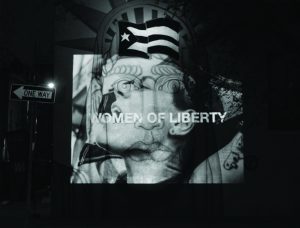
Women of Liberty by 22 Studio (2019). Photo courtesy of the artists.
That same summer, there was so much taking place in Puerto Rico that when the members of 22 Studio began thinking about their activation for the “Puerto Rican Statue of Liberty” mural they knew that there was an opportunity to connect the politics of the present moment to the past preserved in the mural. Looking towards producing an activation in the fall, Nasheli Juliana Ortiz, Marién Vélez and Lorna Mulero of 22 Studio began having conversations with activists and residents in the area around the significance and history of the mural. Inspired by the way the activists in 1977 had unfurled a Puerto Rican flag over lady liberty’s brow, the group decided to install a temporary and contemporary update to the mural featuring the now infamous black and white Puerto Rican flag which has become an icon of resistance on the island and in the diaspora since it was painted over a highly visible flag by the anonymous art-activist group La Puerta back in 2016 (Agrelo, 2019). As a second layer to the intervention, across two nights in November the group projected a video made about Puerto Rican women’s activism and leadership in the movement of the summer of 2019 that led to the resignation of Puerto Rico’s then Governor Ricardo Ricky Rosselló.
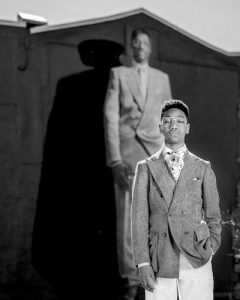
Larger than Life by Ken McFarlane (2020). Photo courtesy of the artist.
As the earth completed another orbit around the sun, in this little corner of Philadelphia 2020 began with plans for three more Historic Mural Activations. The first was Ken McFarlane’s activation of the “Dr. J” mural. McFarlane had lived near the “Dr. J” mural when it was painted and considers it a landmark for his time in that neighborhood. A few years prior he had produced the series “From the Root to the Fruit: Portraits of Black Fathers and Their Children” on the exterior walls of Traction Company on 41st Street and Haverford and was interested in revisiting one of the families he had photographed for that project. On March 1st McFarlane assembled a team of friends and younger media makers he was mentoring on a sunny Sunday morning for a photoshoot on site at the “Dr. J” mural. In this work he depicts Philadelphia-native Erik Honesty II, now a teenager who McFarlane had photographed alongside his father for “From the Root to the Fruit.” For this shoot his father Erik Honesty did the styling and wardrobe to be an update to Dr. J’s suit from the mural, and by putting the younger Erik Honesty II in dialogue with the massive scale of the Dr. J. mural, McFarlane’s resulting work considers the role fashion and style play in shaping dignity and stature, as well as the promise of youth as a means to understand some of the ways power functions in society.
Only a few weeks later, the artist Eva Wǒ began planning a multi-part activation of the “Pride and Progress” mural by Ann Northrup on the side of The William Way Center. With photoshoots planned for William Way Center’s ballroom space for March 18th and 20th of 2020, the food was ordered and the space was reserved. And then the shutdown happened and the shoots were canceled. Pivoting during a public health pandemic is not easy.there is a great deal to worry about besides making historic mural activations, but quickly Wǒ found the space to reformulate this work in a physically-distanced manner, doing most of the project over email.
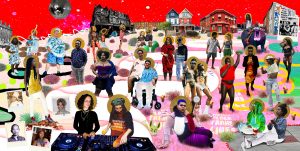
Post-Supremacy Portal by Eva Wǒ. Photo courtesy of the artist.
When I got in touch with Wǒ about participating in the project, she had immediately been interested in whether the mural painted on the side of William Way Center had been painted by a queer-identified artist. There were aesthetic indicators that made Wǒ question this and as I shared the recorded interviews with Golden and Northrup, she confirmed that the same questions came up in the creation of the mural. As a way to constructively dive into the implications of this link between maker and mural in a manner that looked forward rather than back, Wǒ used this as a prompt to ask questions of queer artists working today what they considered to be the signifiance of having queer artists represent queer communities. The result was a photo collage update of the mural alongwith a zine that features detailed interviews with 16 artists about the politics of queer representation today. Taken together the 2-part project is rich with lessons and insights premised on the disability-rights movement slogan “nothing about us without us.”
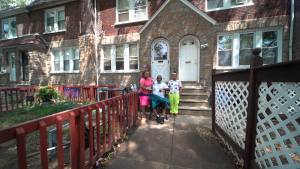
Brother Gerald Bolling from Black Family Reunion (2020) by Marie Alarcon. Photo courtesy of the artist.
There was one project still in development as the pandemic hit and so the pivoting was more gradual than abrupt for Marie Alarcon’s activation in response to the “Black Family Reunion” mural near West Fairmount Park. Alarcon had both made work about Black community cohesion and identity in West Philadelphia and had also been living in the area near the mural for many years. Based on these connections, she had become familiar with several people who had grown up in the neighborhood, moved away, and then returned as older adults. This intrigued her as a kind of updated interpretation to what it meant to be a Black family unit today and what the concept of “reunion” meant in the very neighborhood where the mural was located. Jumping off from that premise Alarcon had to resolve how to produce video portraits and interviews using physical-distancing for the four people she ended up profiling, and to make a work that would live entirely online. The resulting video captures a moment in time and elegantly, respectfully (and safely!) weaves together the experiences of four individuals seeking out community in the Belmont and Mantua neighborhoods. In this depiction Alarcon creates a layered view of a place that expands our sense of the stakes of belonging today.
While the exhibition of artworks made through the activations planned for the Summer of 2020 had to be pushed back, the revised timeline for “Power Map” offered an opportunity to take the three live activations and the two pandemic activations into a virtual space that could build on a partnership between MAP and the online Public Art Archive (PAA) to document and map the past work of Mural Arts and highlight special projects. The resulting virtual exhibit allows the geographically-linked map of the PAA’s collection management system to put the historic murals on equal footing with the newly commissioned activations. The result is truly exciting and in a moment of disappointing project cancelations, it stands out as a solution to pandemic art documentation that really expands what is possible from a conventional exhibition format.
Looking forward, there is room to use these/MAP’s murals as prompts to consider not just how they witness change but also how the way we witness and see has changed. Our conceptions of power and how to depict it may no longer be limited to an anonymous figure raised an arm alongside a powerful quotation, an iconic athlete in a suit, old family photos showing where we’ve been, the image of queer normalization, and the depiction of emboldened direct action advancing national independence. And yet, these approaches offered starting points for the incredible range of concepts pursued by the “Power Map” artists who put these murals in dialogue with contemporary concerns about ownership of land, women’s rights, Black dignity, community cohesion and the politics of representation. The layering of activation on top of or inspired by or in dialogue with the original mural also demonstrates ways to engage the past with contemporary concerns.
Taken together these projects generously offer us a map for making images that deal with power as it currently exists. They offer insights into the key questions facing artists today about how to see and reveal the complex and urgent questions of our time. If we follow this map we can be led to a world of image-making that leads us in many directions at the same time – drawing from the past, but alive and unfolding.
Footnotes:
Interviews were conducted by the author with Jane Golden on May 22, 2019, with Ann Northrup on December 13, 2019 and with Kent Twitchell on February 21, 2020. Thanks to Hal Martin for their transcription of the interviews with Jane Golden.
- Agrelo, Justin “How a Change of Color for the Puerto Rican Flag Became a Symbol of Resistance” 7/4/19 in Mother Jones https://www.motherjones.com/media/2019/07/puerto-rico-resistance-flag-black-and-white-flag-san-juan-la-puerta-colonial/
- Alkalimat, Crawford and Zorach, The Wall of Respect: Public Art & Black Liberation in 1960s Chicago (Northwestern, 2017);
- College Art Association forum “What do you think? On the Victor Arnautoff Murals and Controversial Artworks” posted by CAA — Sep 09, 2019 http://www.collegeart.org/news/2019/09/09/controversial-artworks-survey/ ;
- Donaldson, Jeff “The Rise, Fall, and Legacy of the Wall of Respect Movement” published in the International Review of African American Art (1991) and reprinted in The Wall of Respect: Public Art & Black Liberation in 1960s Chicago. Editors Alkalimat, Crawford and Zorach, p294 (Northwestern, 2017);
- Jones-Hogu, Barbara “The History, Philosophy and Aesthetics of AFRICOBRA” Originally published in Afri-Cobra HI (Amherst: University of Massachusetts at Amherst, 1973). Revised by the author, for AREA Chicago #7 in 2008. https://areachicagoarchive.wordpress.com/2019/02/23/the-history-philosophy-and-aesthetics-of-africobra/
- Olivier, Karyn https://www.washingtonpost.com/opinions/2020/07/06/removing-an-offensive-mural-university-kentucky-isnt-racial-justice/
- Ortiz, Michelle Angela “Cleanse” 2020 https://www.michelleangela.com/cleanse
- Ralph, Pat “Frank Rizzo mural in Italian Market to be removed, replaced with new artwork” JUNE 03, 2020 in Philly Voice https://www.phillyvoice.com/frank-rizzo-mural-south-philly-italian-market-mural-arts-philadelphia/
- Santiago, Luis Vargas Zapatista Muralism and the Making of a Community published in Dancing with the Zapatistas: Twenty Years Later, edited by Diana Taylor and Lorie Novak (Duke University Press, 2015) online at https://scalar.usc.edu/anvc/dancing-with-the-zapatistas/zapatista-muralism-and-the-making-of-a-community

